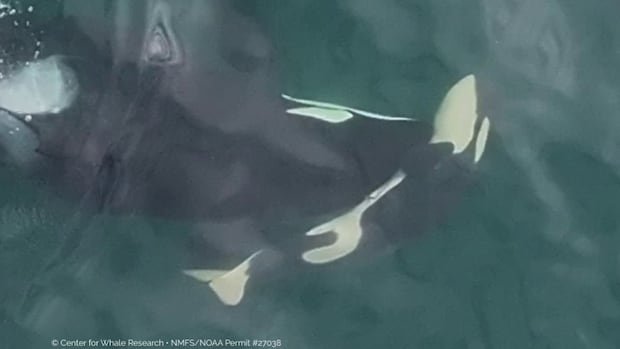Whale experts have reported that a critically endangered southern resident killer whale was discovered nudging a deceased calf in the Salish Sea on Friday. This sighting may evoke memories of a similar incident involving another mother whale back in 2018, which garnered global attention.
The Center for Whale Research (CWR) based in Washington state shared on social media that they were informed of sightings of the orca named J36 in Rosario Strait, situated around 45 kilometers northeast of Victoria, Washington. Researchers from the CWR observed J36 pushing a dead female calf with an umbilical cord still attached. They estimated that the baby whale was likely born within the past three days.
According to the CWR’s social media post, based on the size of the calf, it was determined that it was either at full term or close to it. The circumstances surrounding the calf’s death, whether it was a stillbirth or occurred shortly after birth, remain unclear.
Michael Weiss, research director for CWR, highlighted that most pregnancies in the southern killer whale population do not lead to the survival of calves. Weiss mentioned that many females in the population experience pregnancies resulting in calf deaths shortly after birth or stillbirths. He emphasized that this occurrence is not often witnessed, potentially happening multiple times a year.
Weiss pointed out the potential factors contributing to the low reproductive success in the killer whale population, including high levels of pollutants like PCBs affecting immune and reproductive functions, and the scarcity of prey, particularly Chinook salmon, which are crucial for orcas.
Researchers have noted that the behavior of a mother orca pushing a deceased calf is likely an expression of grief. Weiss explained that the bond between a mother killer whale and her calf is enduring, with the mother nursing the calf for three years after carrying it for 18 months, forming a lifelong family bond.
J35, another female orca in the J pod, made headlines in 2018 when she carried her dead calf for 17 days, covering over 1,600 kilometers in what researchers described as a poignant display of grief. In early 2025, she was once again observed pushing another deceased calf.
The southern resident killer whales, a unique group of orcas with fewer than 75 individuals left, inhabit the Salish Sea near Vancouver Island and Metro Vancouver, relying on salmon as their primary food source. J36 is a member of the “J pod,” part of the southern resident killer whale community identified by names starting with the letter “J.”
The CWR team was present at the scene on Friday gathering more data on J36 and her deceased calf, with plans to share additional information as it becomes available. Earlier reports warned of the impending extinction of the southern resident killer whales unless urgent conservation efforts are implemented.

